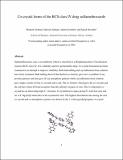Cocrystal forms of the BCS class IV drug sulfamethoxazole

View/
Date
2018-05-23Author
Alsubaie, Moneerh
Aljohani, Marwah
Erxleben, Andrea
McArdle, Patrick
Metadata
Show full item recordUsage
This item's downloads: 487 (view details)
Cited 11 times in Scopus (view citations)
Recommended Citation
Alsubaie, Moneerh, Aljohani, Marwah, Erxleben, Andrea, & McArdle, Patrick. (2018). Cocrystal Forms of the BCS Class IV Drug Sulfamethoxazole. Crystal Growth & Design, 18(7), 3902-3912. doi: 10.1021/acs.cgd.8b00216
Published Version
Abstract
Sulfamethoxazole, smz, is an antibiotic that is classified as a Biopharmaceutics Classification System (BCS) class IV, low solubility and low permeability drug. Cocrystal formation has been examined in an attempt to improve solubility. Both ball milling and crystallization from solution have been examined. Ball milling showed that 13 coformers gave new crystalline X-ray powder patterns, and four gave X-ray amorphous patterns, while crystallization from solution gave single crystals of four cocrystals and a salt. The coformers that gave the cocrystals and the salt have better H-bond acceptors than the sulfonyl oxygens of smz. The 4,4-dipyridyl cocrystal has an interesting high Z′′ structure. It crystallized in space group P1 with four smz and six 4,4′-dipyridyl molecules in the asymmetric unit. The highest dissolution rate among the smz cocrystal and co-amorphous systems was shown by the 1,3-di(4-pyridyl)propane cocrystal.

